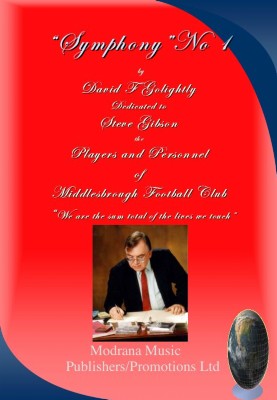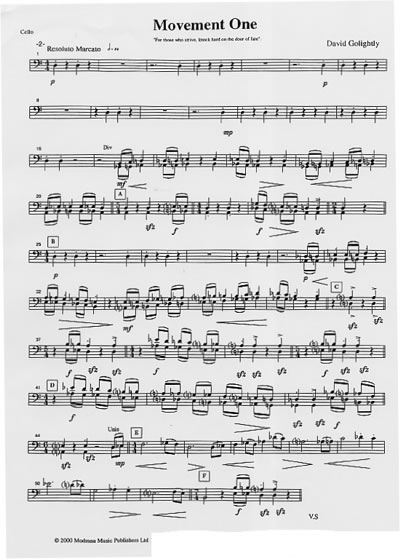Brass: French Horns 1.2.3.4 Trumpets 1.2.3.4 (D useful for first); Trombones 1.2 Bass Trombone Tuba (C useful for movement three)
Percussion: Timpani
Players 2.3.Bass Drum Cymbal (Suspended Clashed rolled, soft sticks) Xylophne (large hard sticks) Vibraphone (Soft sticks) Snare Drum. Whip. Tam Tam (Large soft sticks)
Harp (Movement 2.3.4.); Celesta (Movement 2.4) Strings (Five String Basses needed)
Orchestral parts available from the publishers on a hire or purchase arrangement: info@modranamusicpromotions.com
Symphony in 4 movements
Available here
 |
Symphony
No 1 - David Golightly:
City of Prague Philharmonic Orchestra Conducted Gavin Sutherland. Click Album cover for additional information & sound clips |
of Recording
and of the work
DAVID
GOLIGHTLY Symphony no 1; Three Sea Scapes City of Prague Philharmonic
Orchestra (conducted by Gavin Sutherland) (recorded
28-30 August, 2000) ASC Records CS CD38 [54:41] Though he has composed
extensively for theatre and film in this country, David Golightly+s music
is better known abroad. In particular he has strong links with St Petersburg,
for whose Rouss-land Soglasie Choir he wrote The St Petersburg Mass,
which was received in the city to great acclaim. Indeed the choir''s
conductor
went so far as to describe him as ''The Englishman with a Russian soul''.
His Piano Sonata recently received its first performance at New York's
Carnegie Hall, and will be heard later this month in Oxford. From the
age of nine, he has been an ardent supporter of Middlesbrough FC, and
this
symphony must be regarded as being the first-ever which is not only dedicated
to a football club and its chairman but an orchestral portrait of the
game. In fact, the work's programme is intensely personal. ''My symphony
was
composed as an attempt to chart in musical terms the struggles, successes
and failures which I have encountered on life''s journey'', says the
composer, and in it he has also sought to encapsulate the fluctuating
fortunes of
his team. Golightly possesses a distinctive musical voice - tonal in
idiom, by turns gritty and lyrical in style, but constantly underpinned
by insistent
rhythmic energy and clothed in assured orchestral colours. A feature
of the first three movements is their enigmatic, throwaway endings.
Richly-scored
and impassioned though it is, the slow movement suggests that the composer
is striving to rein in his romantic inclinations. But any inhibitions
he may have are cast to the winds in the turbulent finale - a portrait
of
an actual football match - and the serene C major ending is utterly captivating.
Given limited rehearsal time, young conductor Gavin Sutherland and his
forces play with evident commitment, only the somewhat fragmentary
second movement shows signs of strain. Recording sound is vivid but lacks
bloom
and ambience. The disc is completed by Three Sea Scapes, masterly arrangements
of three shanties. Golightly is certainly a composer to watch, and this
symphony is warmly recommended.
Performance ***
Sound ***
Reviewer: Adrian Smith Classical Music Web Site
It may seem extraordinary, but David Golightly''s Symphony No 1, written over a period of four years, was commissioned and dedicated to Middlesbrough Football Team and its Chairman, Steve Gibson. Essentially programmatic, it is effectively wrought with a first movement founded on a rhythmic ostinato (Resoluto marcato) "for those who strive, knock hard on the door of fate", the scherzo reflecting the lively optimism of visits to Wembley, the eloquent and imaginatively scored slow movement reflecting the pain of defeat in an idiom that reminded the writer a little of the spacious string writing of Howard Hanson.
The finale is ajaunty populist march, exotically scored with the two-part structure reflecting the two halves of the game. The orchestral fanfares depict the team scoring. It is a happy extrovert inspiration and receives a fine performance under Gavin Sutherland in Prague and a full-blooded recording. The three Seascapes further demonstrate Golightly''s vivid orchestral skill, using well-known folk-themes, like Shenandoah. The disc is available from Modrana Music Publishers Limited.
Penguin Mr Ivan March
Golightly's symphony
is a big, ostinato-driven, muscular piece, tonal and constructed out of
the musical equivalent of big, solid blocks, or painted in broad brush-strokes
of primary colors. It seems to be the proof in music of Grainger's words
to the effect that the English are 'passionless about everything except
football' - because it is dedicated to a football club (Middlesbrough)
and its manager, and extrapolates from these men of sport and mud to hypothetical
Promethean strivers, builders and visionaries everywhere. Whether or not
you are as passionate as Mr. Golightly about soccer, the symphony is one
of those big-boned, tonal, neo-romantic pieces which can be relied upon
to get the blood pumping a little faster. The Seascapes are appealing orchestral
fantasias in familiar style, also bold and colorful. City of Prague Philharmonic
Orchestra; Gavin Sutherland.
Reviewer Jeff Joneikis Records International
This
symphony is unusual, perhaps unique, in being inspired by and supported
by a football
club (Middlesbrough, who are playing extracts
on match days).There
is otherwise little original football music: some songs, insignificant
musically, one or two library "titles" and John Ireland's Housman
setting Goal and Wicket.The strongly marked opening sets the scene:the
deliciously scored, often delicate, scherzo expresses the joy of the club's
Wembley visits, the Espressivo Sostenuto the pain of defeat. The marchlike
finale,suggesting the excitement of a match day and, in wider terms, a
questing journey through life, ends quietly, movingly indeed, as events
on the field or through life are recollected in tranquillity. Some 45 minutes
long, the Symphony is very accessible in idiom, a "Classic FM work",
no more "difficult" than say George Lloyd or William Alwyn (Golightly,
like Alwyn, has composed film music), with traces of Shostakovich;s influence.
It is well argued, though the preludial first movement might be slightly
shorter with advantage, and finely scored. The performance by the Prague
players under Sutherland's assured direction is excellent. The filler
is attractive, too: a lightish suite, each movement based on a different
sea-shanty:
Fire Down Below, Shenandoah and Rio Grande. Worth investigating
Reviewer Philip L Scowcroft The British Music Society
Middlesbrough Football Club Energetic
sports and the high art might seem to be completely opposite expressions
of human endeavour; one being concerned with sheer physical exuberance
and even a macho triumphalism, the other with matters of the spirit: the
intellect and the communication of subtle emotional experiences. Perhaps
both are different sides of the same coin of human self-expression. David
Golightly, former student of Huddersfield University Music Department,
in the days when it was a more modest Polytechnic, was even then already
a
prolific composer, burgeoning with imaginative ideas. Now, years later,
his imagination, no less his technique as a composer has matured. There
are perhaps not many specifically avowed instances of sport directly inspiring
serious music: certainly not symphonic music on the scale of this work
dedicated to Golightly's admired Middlesbrough Football Club and its manager,
Steve Gibson. The nearest that immediately comes to mind must surely be
Honegger's Rugby of 1928. Many musicians and 'arty' people who might not
at first sight be thought to have much interest in macho sports, do follow
the fortunes of their favourite team, whether it be football, cricket,
motor sport or whatever else. However, having declared a committed support
of his team, and been hearteningly inspired by what it stands for, the
music itself exists firmly on its own terms: it is after all, a pure and
abstract symphonic creation. In this it succeeds most convincingly. The
sleeve notes hint at Golightly's Russian connections, and this is aptly
summarised by a Russian commentator, Alexander Govorov, who declares that
the composer is the 'Englishman with a Russian soul'. It could well be
that Golightly will come to be regarded as an English Shostakovich; there
are numerous stylistic similarities to the Russian model: those driving
motor rhythms, and characteristic, slender wisps of solo themes; and above
all the relentless on-going energy, so often dark-toned and uncompromising.
Perhaps its greatest asset is its most assured and brilliant sense of orchestral
colour. As with Russian muse in general, this symphony is apt to be expansive
in length, and it just could be thought that some of the material, despite
its fascinating orchestration, might, in a purely musical-structural sense,
benefit from some more subtle and varied thematic development rather than
the, particularly rhythmic, repetition it tends to display. But there
is no mistaking the fact that this is indeed an arresting and captivating
symphonic piece of music; immediately approachable, its message clear and
distinct.
Arthur Butterworth Philharmonic Magazine December 2000

Cello part
